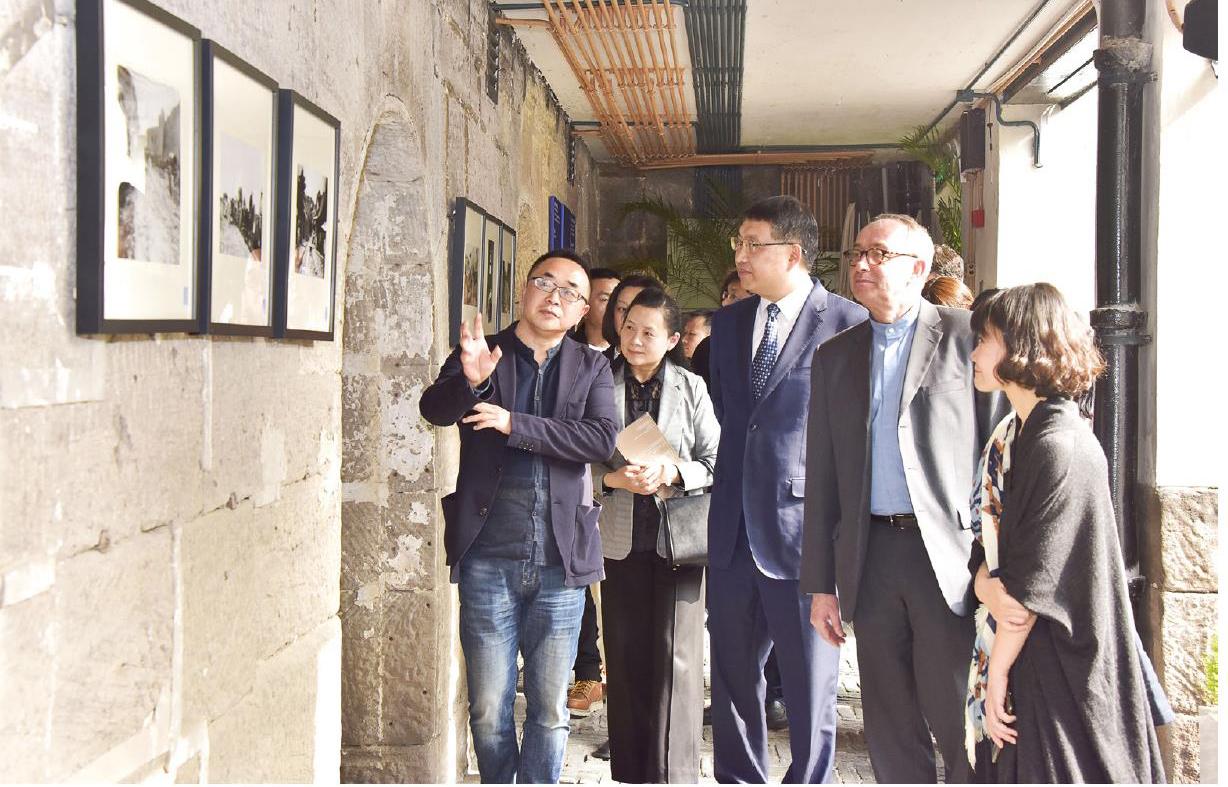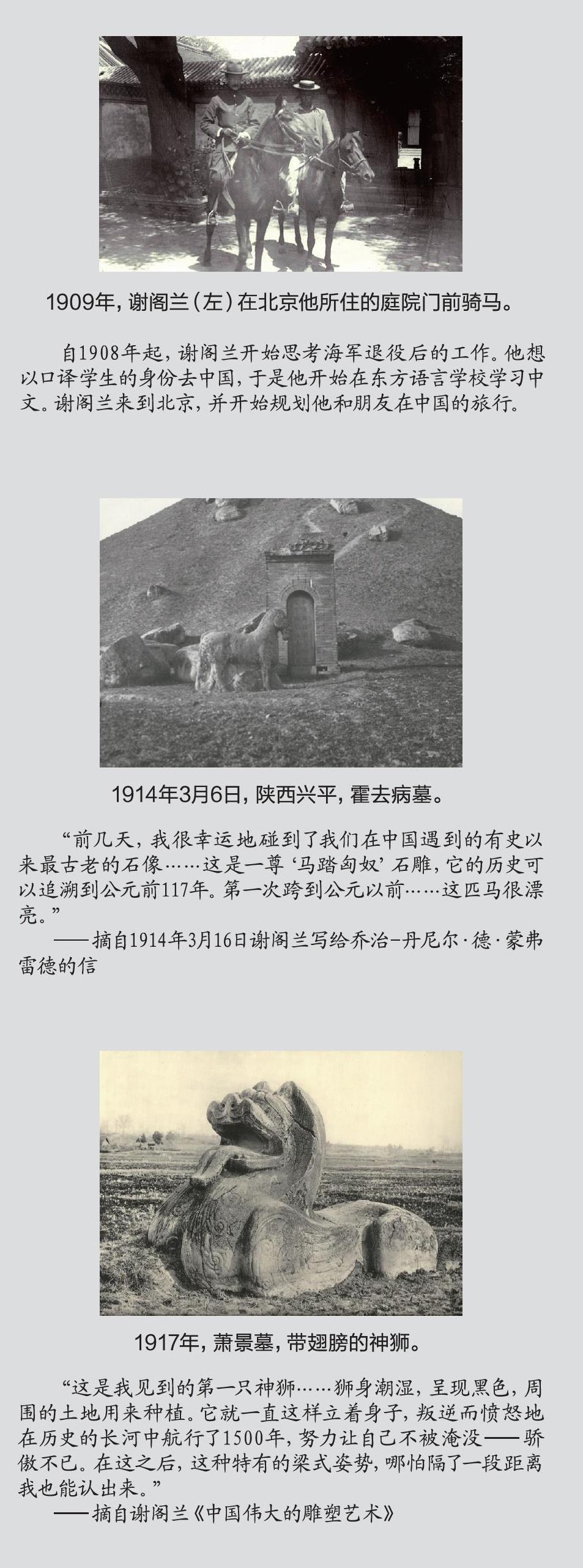“谢阁兰的中国印迹—中国古代遗址的视觉想象”在重庆展出法国汉学家Segalen百年前的中国之旅
2021-05-20贺煜
贺煜



3月18日—4月20日,四川美术学院和法国驻成都总领事馆联合在重庆南岸法国水师兵营旧址举办“谢阁兰的中国印迹—中国古代遗址的视觉想象”展览。此次展览是第25届“法语活动月”活动之一。
展览汇集著名法国汉学家谢阁兰(Victor Segalen)考察中国的摄影作品近100幅(复刻版),分为“谢阁兰”“旅程”“遗迹”“文字”4个单元,分别从谢阁兰的日常生活、旅途记录、考古研究、手稿等方面追溯他的中国之旅,以及他对艺术的追求与探索。这些作品既是对早期摄影艺术的表现和图像叙事的回顾,也是对中国西部的历史文化和文化遗产进行图像复原的尝试。
据法国驻成都总领事白屿淞介绍,谢阁兰(1878—1919年)是法国著名诗人、作家、汉学家和艺术史学家,也是外科医生和民族志学者。他曾长期旅居和多次游历中国,对中国的悠久文明和独特文化有着深入的体察和丰富的感知,并以此为灵感创作出大量作品,被称为“法国的中国诗人”。
作为最早进入中国西部考察的西方学者,谢阁兰分别于1909年、1914年和1917年,先后组织了3次对中国古代遗迹的考古调查。随后他创作了旅行笔记《砖与瓦》《路线图》,以及丰富的书信。
四川美术学院教授秦臻是谢阁兰《汉代墓葬艺术—中华考古记(1914)》中文版的编译者之一。据他介绍,谢阁兰的第一次中国之旅是从法国马赛启航,由香港到北京,再到兰州、成都,于1909年12月31日到达重庆。虽然他留下的文字没有详细记载重庆的内容,但他在给夫人的一封信中这样描述:“随我们从四川来的小马让人捧腹大笑,它们很轻松地就登上了重庆江边上百级的台阶,其灵敏性激怒了从北京就开始伴随我们而来的这些马匹。”谢阁兰在重庆度过了新年,于1910年1月5日前往武汉并回到法国。
谢阁兰的第二次中国考察则构成了他学术上非常重要的系列著作,包括《汉代墓葬艺术—中华考古记(1914)》。谢阁兰去世后,他的同伴让·拉尔蒂格编辑完成了这一著作。该书是谢阁兰于1914年对陕西、四川等地区秦汉时期墓葬遗迹和陵墓建筑、雕塑,进行详细考察后的记录和分析、研究的成果。2020年,文物出版社出版了《汉代墓葬艺术—中华考古记(1914)》中文版,由秦臻和法国语言文学博士李海艳共同编译。
在中国考察期间,谢阁兰留下了大量的历史、文化和民族志的摄影图片,現藏于法国国家图书馆、法国吉美东方博物馆及谢阁兰基金会等地。在谢阁兰拍摄的数百张照片中,记录了在中国考古发现的各类历史遗存,也记录了考察途中的人情事态,以及山川、河流、房舍、旅人等各类风物印象。这些照片既体现了谢阁兰兼具诗人与艺术史学者的双重属性,对中国古代遗存和古代艺术品进行认知和研究的影像,也是他作为外国人对中国历史文化的观察,是他在中国文化土壤上书写的诗歌篇章。
“谢阁兰留下的珍贵摄影图像与手稿文献,是对中国古代雕塑与遗迹的真实写照,同时也体现出他对田野考察、历史研究的热爱与激情。”四川美术学院国际交流合作处处长曾岳评价,谢阁兰对中国历史文化遗迹的研究与考察具有前瞻性,不仅是其对于个人研究领域的充实与丰富,也是法国学者研究精神与法国文化熏陶的集中体现,更是对中国传统遗迹的即时性保存与传承,让今天的我们能够透过历史的镜头重新审视这片文化深厚的土地。
资料图片/法国驻成都总领事馆提供
From March 18 to April 20, Sichuan Fine Arts Institute and Consulate General of the Republic of France in Chengdu jointly hold the exhibition "Voyages en Chine de Victor Segalen, A La Rencotre de Sites Anciens" at LICHEE - former site of Marine Francaise in Chongqing. This exhibition is one of the events conducted during the 25th "Mois de la francophonie".
A collection of nearly 100 photographic works (reprints) of the famous French sinologist Victor Segalen's visit to China, the exhibition includes four chapters: "Victor Segalen", "Voyages", "Vestiges arch é ologiques" and "Texte", tracing his journey to China from day-to-day life, travel records, archaeological research, manuscripts, and other aspects, as well as his pursuit and exploration of art. These works are not only a retrospect of early photographic art manifestation and image narrative, but also an attempt to restore the image of history, culture, and cultural heritage of Western China.
According to the introduction of Bruno Bisson, Consul General of France in Chengdu, Victor Segalen (1878-1919) was a renowned French poet, writer, sinologist, and art historian as well as a surgeon and ethnographer. Having lived in China for a long time and traveled in the country for multiple times, he had a deep understanding and rich perception of China's time-honored civilization and unique culture, which in turn inspired his creation of a myriad of works, thus he was known as "Chinese poet of France".
As the first Western scholar to visit Western China, Victor Segalen organized three archaeological surveys on ancient Chinese art and sculpture in 1909, 1914 and 1917 respectively. He then wrote travel notes Briques et tuiles, Feuilles de Route, and numerous letters.
Qin Zhen, a professor at Sichuan Fine Arts Institute, is one of the compilers and translators of Victor Segalen's Chinese version of L'art funeraire a l'epoque des Han-Mission archeologique en Chine (1914). According to Qin, Victor Segalen's first trip to China started from Marseille in France via Hong Kong to Beijing, then to Lanzhou, Chengdu, and to Chongqing on December 31, 1909. Though no detailed records of Chongqing were left in his texts, he described in a letter to his wife as follows, "The ponies that came with us from Sichuan were so hilarious as they easily ascended hundreds of stairs along the riverbank in Chongqing, and their nimbleness infuriated the horses came along with us since Beijing." Victor Segalen spent the New Year in Chongqing, then went to Wuhan and returned to France on January 5, 1910.
Victor Segalen's second visit in China helped him complete a series of groundbreaking academic works, including L'art funeraire a l'epoque des Han-Mission archeologique en Chine (1914). After Victor Segalen passed away, his companion, Jean Lartigue, edited and completed this masterpiece. This book is a product of record, analysis, and research of Victor Segalen 's detailed survey of Qin and Han tomb relics, mausoleum buildings and sculptures in Shaanxi, Sichuan, and other regions in 1914. In 2020, the Cultural Relics Press published L'art funeraire a l'epoque des Han-Mission archeologique en Chine (1914), which is jointly compiled and translated by Qin Zhen and Li Haiyan, PhD of French Language and Literature.
During his visit to China, Victor Segalen left a legion of photographs of history, culture, and ethnography, which are now collected by in the La bibliothèque nationale de France, the Musée Guimet and Fondation Victor Segalen. Amid the hundreds of photos taken by Victor Segalen, various historical relics found in Chinese archaeology, social anecdotes en route as well as various impressions made by mountains, rivers, houses, travelers, and other scenery were recorded. These photos not only reflect Victor Segalen's dual attributes as a poet and a scholar of art history, but also reflect his cognition and study of ancient Chinese relics and ancient artifacts, his observation of Chinese history and culture as a foreigner, and his verses written on the soil of Chinese culture.
"The valuable photographic images and manuscripts left by Victor Segalen are an authentic depiction of ancient Chinese sculptures and relics, and also a reflection of his enthusiasm and passion for fieldwork and historical research." Zeng Yue, director of the International Exchange and Cooperation Division of Sichuan Fine Arts Institute, commented that Victor Segalen's research and survey on Chinese historical and cultural relics was forward-looking, not only fulfilled and enriched his personal research realm, but also embodied the research spirit of French scholars and the influence of French culture, and served as the immediate preservation and inheritance of Chinese traditional relics, so that today we could re-examine this profound land through the lens of history.
Information and photos are provided by Consulate General of the Republic of France in Chengdu
